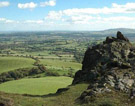Where to stay in Britain: October in Shropshire
Country Life's guide to visiting Shropshire: What to eat, where to stay, and not forgetting Shropshire's famous pies


Local food
For a fidget pie, a filling of pork, fresh or cured, and apples is essential; onions, potatoes, stock, wine and seasoning are usual. The pie could be made in a dish topped with pastry and eaten hot; or it could be a raised pie produced for carrying away and eating hot or cold. The former was made for domestic consumption only; the latter is sometimes seen on sale. The meat is diced, and apples and vegetables prepared. They are placed in the crust in layers. Seasoning, wine or stock is added. The pie is covered with a pastry top, the edges are crimped, the centre is decorated and glazed egg brushed on top. It is baked at 160˚C-170˚C for up to 90 minutes.
Where to stay
The red-brick and timber-framed houses of Shropshire offer every comfort for travellers. For peace lovers
The Pen-y-Dyffryn country-house hotel (01691 653700; www.peny.co.uk) in the hills on the western edge of the county offers a secluded retreat within reach of Oswestry.
For charm and tranquillity
Nearer to the former canal town of Ellesmere, guests at Yew Tree House (01691 622126; www.yewtreebandb.co.uk) will love the B&B's charming 1½-acre garden.
Exquisite houses, the beauty of Nature, and how to get the most from your life, straight to your inbox.
For a smart B&B
Close to the centre of Shrewsbury, Hardwick House (01743 350165; www.hardwickhouseshrewsbury.co.uk) is one of the smartest Georgian residences in town.
For fine food
Mr Underhill's Michelin-starred restaurant (01584 874431; www.mr-underhills.co.uk) at Dinham Weir, below Ludlow Castle, has rooms.
For a taste of history
Former chapel St Winifred's Well (01628 825925; www.landmarktrust.org.uk) at Woolston stands on land that may have been dedicated to St Winifred. She was a 7th-century Welsh princess, sworn to a life of chastity, who was brought back to life by her uncle, St Beuno, after being decapitated by an angry suitor as she ran away to hide in a church. Her body was taken to Shrewsbury Abbey, which became a place of pilgrimage.
Nature Notes
In the south of the county lie the vast ranges of the heather-topped Long Mynd, Stiperstones and Clee hills. Above them, the 73 miles of the River Severn have carved a broad, flat (sometimes flooded, sometimes wooded) plain. To the north are the Meres, jewel-like lakes created at the end of the last Ice Age. Nearby are the Mosses, once lakes, but now filled with peat from sphagnum moss.
Country Life is unlike any other magazine: the only glossy weekly on the newsstand and the only magazine that has been guest-edited by His Majesty The King not once, but twice. It is a celebration of modern rural life and all its diverse joys and pleasures — that was first published in Queen Victoria's Diamond Jubilee year. Our eclectic mixture of witty and informative content — from the most up-to-date property news and commentary and a coveted glimpse inside some of the UK's best houses and gardens, to gardening, the arts and interior design, written by experts in their field — still cannot be found in print or online, anywhere else.
